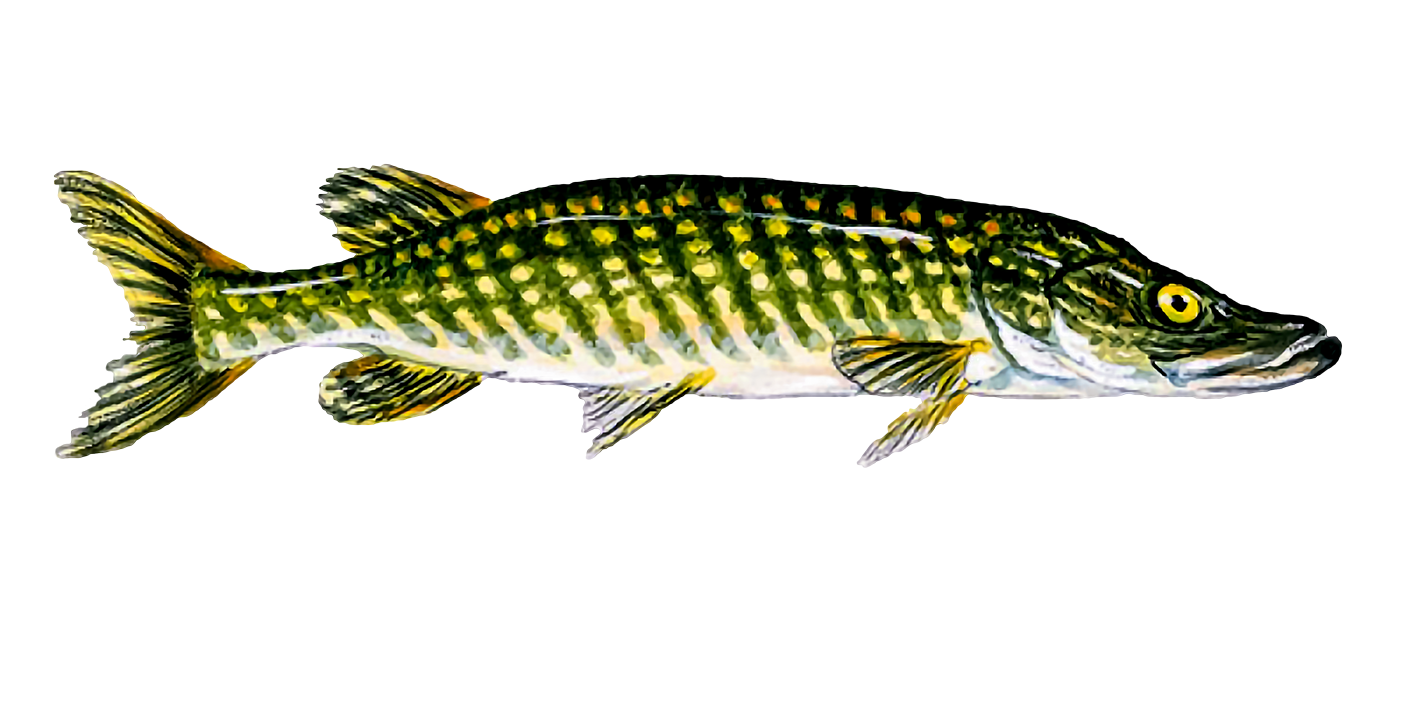

"The Pike is Britain's largest native predatory freshwater fish. Its size has made this fish the target of many anglers hoping for the catch of a lifetime".
Designed by nature for one
specific purpose – to kill. From a very young age Pike kill other fish and,
indeed, each other.
As they mature, so does their taste for blood.
An adult Pike will readily attack another double its size without considering the consequences and big Pike are known to feed on Voles, Mice, Frogs, Ducklings and Moorhens.

Pike (Esox lucius)
Average Weight - Pike caught in the UK usually weigh between 5-11 lbs and have an average length of 22-35 inches (55-85 cm). However, they live for many years and continue to grow throughout their lives, specimens of 35 lbs plus are caught each year. Despite these huge sizes being a possibility, a Pike above 5 lbs will provide a fantastic fight and make an excellent catch for most beginner and intermediate anglers.
Distribution - Pike are widespread throughout Britain and Europe in lowland rivers and lakes. They do not thrive in either highland waters, which tend to be acidic and poor in nutrients, or in fast-flowing spate rivers.
Fast, efficient and streamlined, the Pike cannot be mistaken for any other fish. Most of its characteristics are adaptations to its predatory lifestyle.
Camouflage colouring, eyesight, body form and fin arrangement all contribute to the Pike's success as a hunter.

Pike are widespread throughout Britain and Europe in lowland rivers and lakes. They do not thrive in either highland waters, which tend to be acidic and poor in nutrients, or in fast-flowing spate rivers.

The green and yellow body markings help disguise the Pike as a harmless patch of weed.
The Pike's mouth contains many sharp teeth giving prey little chance of escape.
With their camouflage and short-lived bursts of speed, pike prefer to ambush their prey rather than chase it. They lurk, hidden in the weeds, waiting for the quick sprint — followed by feeding.
The Pike's jaw is extremely flexible, allowing large meals to be swallowed whole; small (Jack) Pike will often demonstrate this by gobbling up their siblings. Prey is usually taken from the side and then manoeuvred round to be swallowed headfirst.
When water conditions prevent the Pike's highly developed eyesight from being effective, it can fall back on its efficient sense of smell. It also has a highly sophisticated tracking system rather like radar.
The Pike's favourite food is fish of between a
tenth to a fifth of the Pike's body weight, but it can swallow much larger ones,
as well as small mammals, frogs and water birds.
However, Pike usually eat only
about two and a half times their own body weight in a year.
Key feeding seasons are dictated mainly by the breeding cycle and water temperature. Sixty per cent of a mature Pike's yearly food intake is consumed in the two months following spawning (round about March and April).
Females also feed heavily in October when their ovaries are beginning to develop, and there is a smaller peak in feeding just before spawning in January and February.
Little is eaten over the summer months as pike tend to be lethargic at higher water temperatures. This means fishing is often poor in summer.

All the Pike's dorsal and anal fins are grouped near the tail giving the Pike tremendous power to launch itself after prey.
Much of the year Pike spend in the deeper water, usually between 3-10m (10-33ft), but in spring, from March onwards, they move into the shallows to spawn.
Females usually carry up to 20,000 eggs per pound of body weight, so large specimens may be carrying more than 500,000 eggs each spring. The Female Pike is much the larger of the sexes weighing up to 20lb (9kg) or more; Male Pikes rarely top 12lb (5.5kg).

The Pike's eyes are set well forward in the head. This provides a degree of binocular vision which helps Pike judge distances. accurately
After spawning, the Pike feeds heavily to regain its strength. The usual victims are other fish, such as Perch and Roach, using the shallows to spawn. Very young Pike eat water fleas and other tiny aquatic life but after only a few weeks they move on to members of their own species and other fly.
Large pike should be returned to the water carefully as they play a vital role in preserving the balance of species in a fishery.
